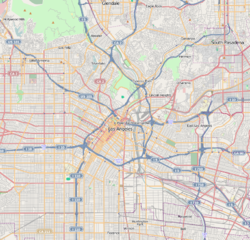
Har Nof is a neighborhood on a hillside on the western boundary of Jerusalem with a population of 20,000 residents, predominantly Orthodox Jews.

The First Roumanian-American Congregation, also known as Congregation Shaarey Shomayim, or the Roumanishe Shul, was an Orthodox Jewish congregation at 89–93 Rivington Street on the Lower East Side of Manhattan in New York City. The congregation was organized in 1885 by Romanian-Jewish immigrants, serving the Lower East Side's large Romanian-Jewish community. The Rivington Street building, erected around 1860, switched between being a church and a synagogue and was extensively remodeled in 1889. The First Roumanian-American congregation purchased it in 1902 and again remodeled it.

Congregation Baith Israel Anshei Emes, more commonly known as the Kane Street Synagogue, is an egalitarian Conservative synagogue at 236 Kane Street in the Cobble Hill neighborhood of Brooklyn in New York City, New York, United States. It is the oldest continuously operating synagogue in Brooklyn.

The Lincoln Square Synagogue is a Modern Orthodox congregation and synagogue located at 180 Amsterdam Avenue between West 68th and 69th Streets in the Lincoln Square neighborhood of Manhattan, New York City.
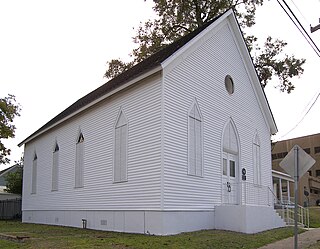
The B'nai Abraham Synagogue is an Orthodox Jewish synagogue and former congregation from Brenham, Texas, in the United States. The congregation was organized in 1885.

Congregation Agudath Shalom, also known as Agudas Sholom the Walnut Street Synagogue or the Walnut Street Shul, is an historic Open Orthodox Jewish synagogue located at 145 Walnut Street in Chelsea, Massachusetts, in the United States.

The Gardens Shul, formally, the Cape Town Hebrew Congregation (CTHC) is a Modern Orthodox synagogue located in the Company Gardens, in the Gardens neighborhood of Cape Town. It has the oldest Jewish congregation in South Africa, dating to 1841. The congregation, known as "The Mother Synagogue of South Africa," possesses two historic structures, the 1863 synagogue known as the Old Shul and the 1905 synagogue. The South African Jewish Museum, located in its grounds, also occupies the Old Shul and is responsible for its upkeep. The 1905 building is an example of Edwardian architecture and has been called "one of the most magnificent synagogues in the world."

Shaarai Torah Synagogue is an historic former Modern Orthodox Jewish synagogue building located at 32 Providence Street, Worcester, Massachusetts, in the United States. Worcester's first Modern Orthodox "shul", Shaarai Torah was considered the city's "Mother Synagogue" for many years.

Stanton Street Synagogue, also known as Stanton Street Shul and Congregation Bnai Jacob Anshei Brzezan, is an Orthodox Jewish synagogue located at 180 Stanton Street on the Lower East Side of Manhattan, in New York City, New York, United States.

Aaron L. Raskin is an American Chabad Lubavitch rabbi and writer. He serves as spiritual leader of Congregation B'nai Avraham, an Orthodox synagogue in Brooklyn Heights, New York, and dean of Brooklyn Heights Jewish Academy.

Young Israel of Flatbush is a historic former Orthodox Jewish congregation and synagogue, located at 1012 Avenue I in Midwood, Brooklyn, New York City, New York, United States. The congregation worshiped in the Ashkenazi rite.
Shaarey Tphiloh is a Modern Orthodox Jewish congregation and synagogue located at 400 Deering Avenue, in Portland, Maine, in the United States. The congregation claims it is the oldest continuously operating synagogue in Portland. The name of the synagogue literally means "Gates of Prayer" in Hebrew.
Congregation Shomrei Emunah is an Orthodox Jewish synagogue located at 5202 14th Avenue, Borough Park, Brooklyn, in New York City, New York, United States.

Jews in Los Angeles comprise approximately 17.5 percent of the city's population, and 7% of the county's population, making the Jewish community the largest in the world outside of New York City and Israel. As of 2015, over 700,000 Jews live in the County of Los Angeles, and 1.232 million Jews live in California overall. Jews have immigrated to Los Angeles since it was part of the Mexican state of Alta California, but most notably beginning at the end of the 19th century to the present day. The Jewish population rose from about 2,500 in 1900 to at least 700,000 in 2015. The large Jewish population has led to a significant impact on the culture of Los Angeles. The Jewish population of Los Angeles has seen a sharp increase in the past several decades, owing to internal migration of Jews from the East Coast, as well as immigration from Israel, France, the former Soviet Union, the UK, South Africa, and Latin America, and also due to the high birth rate of the Hasidic and Orthodox communities who comprise about 10% of the community's population.
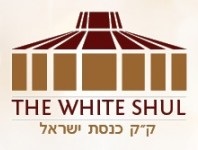
The White Shul, officially Congregation Kneseth Israel, is an Orthodox Jewish congregation and synagogue located in Far Rockaway, in Queens, New York City, New York, United States. The congregation was established in 1922 as Talmud Torah Kneseth Israel and was nicknamed "The White Shul" after its white marble building. The original building located at Nameoke Street and Dinsmore Avenue was destroyed."
Los Angeles, California contains one of the largest concentrations of Israeli Americans in the United States. Israeli Americans are those who are Israelis through nationality and/or citizenship. While the vast majority of the Israeli American populace is Jewish, it is also made up of various other ethnic and religious minorities.
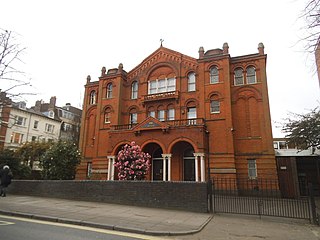
New London Synagogue is a Masorti Jewish congregation and synagogue, located in St John's Wood, in the City of Westminster, London, England, in the United Kingdom.
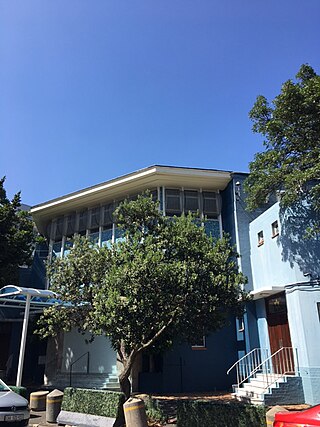
The Marais Road Shul, formally, the Green & Sea Point Hebrew Congregation (G&SPHC) is a notable Modern Orthodox synagogue in Sea Point, a seaside suburb of Cape Town. The congregation was first established in 1926, and the synagogue was completed in 1934. It had initially intended to become a branch of the Gardens Shul in the City Bowl, but opted for independence, and became the larger of the two. It is the largest Jewish congregation in South Africa, and by 1994, it had become the largest in the South Hemisphere. The Sephardi Hebrew Congregation, established in 1960, also operates a shul from the G&SPHC's Weizmann Hall on Regent Road in Sea Point.

